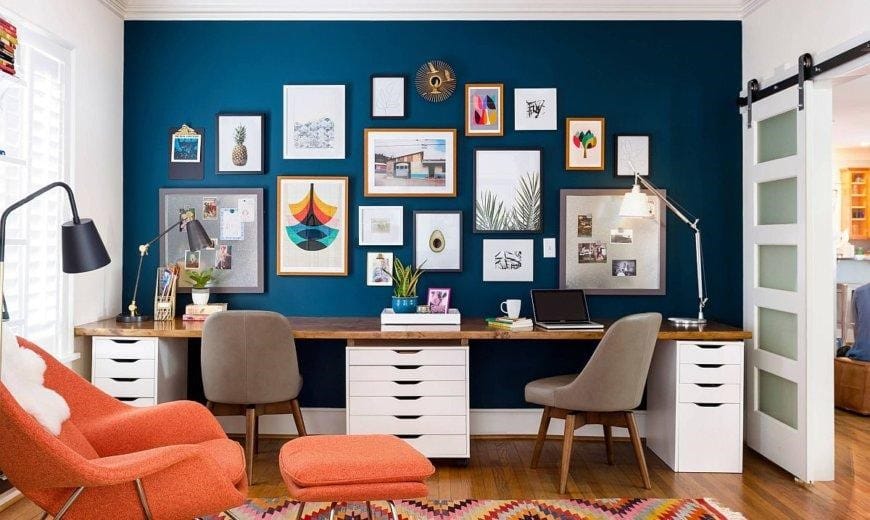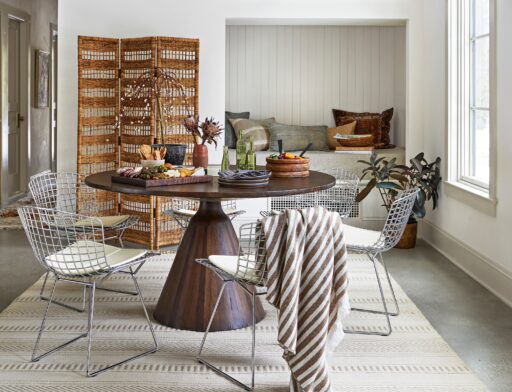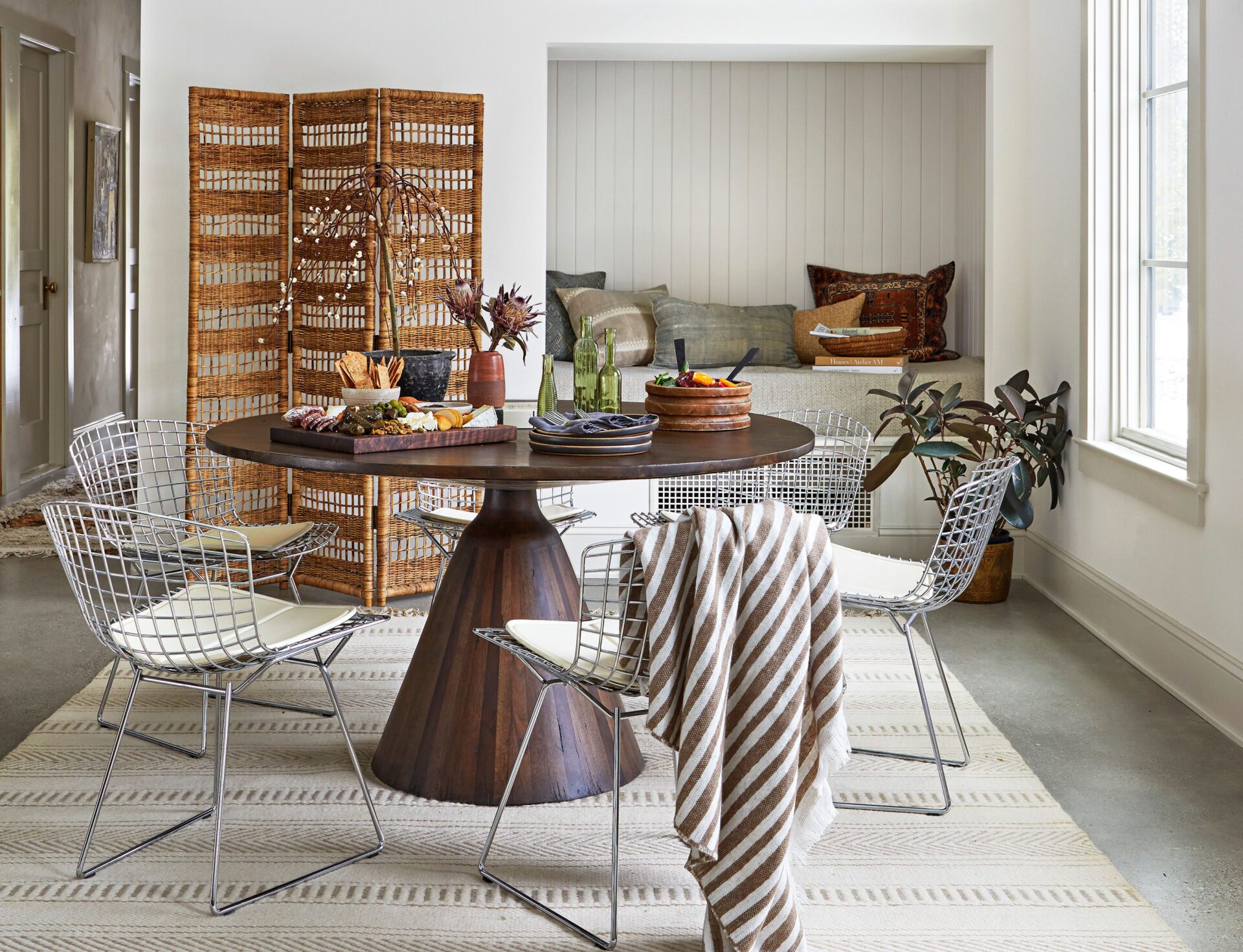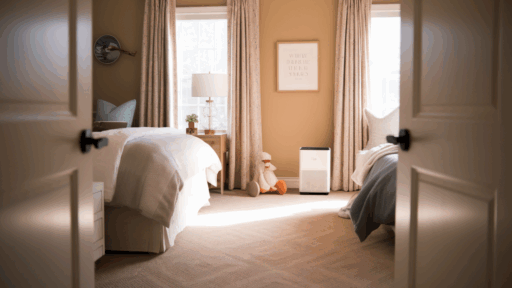That wall beside your dining table doesn’t seem like much at first. Maybe it’s narrow, tucked between two windows, or just sitting there, empty, bland, and slightly off-balance. It’s not big enough for a cabinet, not quite right for a whole art wall, and somehow ends up being the most overlooked spot in the room.
However, in a space designed for gathering and connection, even a small wall can significantly impact the overall ambiance of the room. It can make the area seem unfinished or even disrupt the flow between furniture, lighting, and foot traffic. You might have hung a clock there once, or maybe a random photo frame, but it still doesn’t feel right.
So, what should you do with that awkward wall beside the dining table?
Start with Why That Wall Matters
Some walls are easy to design around. This one isn’t. That narrow, off-center, or uneven space beside the dining table often disrupts the visual balance of the entire room.
In many homes, this wall ends up underused, not because of a lack of ideas, but because it’s hard to define. It’s not a focal point like a beautiful Amish-made round dining table. It’s not a natural place for storage or seating. It often sits at the edge of high-traffic areas, such as the kitchen or living room. That combination of location and in-between size makes it tricky.
What’s often overlooked, though, is that this type of wall can become one of the most valuable features in the room. With a clear purpose, whether visual, functional, or both, it can help create better flow, add warmth, or solve a space problem you didn’t know had a solution. When done right, it’s no longer a design flaw. It becomes an advantage.
Check Your Space Before Choosing a Fix
Before deciding how to use the wall beside your dining table, it’s essential to understand what you’re working with. The layout, lighting, and daily use of the space will all influence what kind of solution makes sense. Start with these key questions:
- Is the wall full height, or broken up by windows or trim?
A full-height wall gives you more flexibility for tall furniture, shelving, or bold visual elements. If it’s interrupted by windows or partial columns, you’ll need to think in layers, using art, low furniture, or even texture to avoid clutter.
- How much foot traffic passes by?
A wall that borders a high-traffic path to the kitchen, hallway, or patio must remain clear of obstructions. Bulky furniture or deep shelving can create bottlenecks. In these cases, flat decor, such as framed art, a shallow console, or even mounted lighting, makes more sense.
- How much natural light hits the wall?
Bright walls can handle darker colors or heavier materials. A dim area may benefit from the addition of mirrors, lighter finishes, or lighting fixtures to enhance the space’s brightness. If the wall often falls in shadow, avoid hanging decor that feels too heavy or dense.
- What’s the overall size of your dining area?
Small spaces need breathing room. In tighter rooms, floating shelves or wall-mounted pieces can create a significant impact without occupying precious floor space. In larger dining rooms, the wall can support added functions, such as hidden storage or even extra seating.
- What materials are already in the space?
If you already have solid wood chairs or a handcrafted dining table, you can carry that same warmth into the wall design. Using wood-framed mirrors, reclaimed shelves, or a matching sideboard will help everything feel intentional, not pieced together.
Take a few minutes to sketch or photograph the area from different angles. The goal is to match the right idea to the reality of your room, not just what looks good online. Once you’ve done that, it’s easier to move forward with confidence.
Use These 7 Smart Ideas to Make That Wall Work

Once you’ve assessed your space, the next step is choosing a solution that fits. Below are practical ways to transform that awkward wall into something functional, attractive, and seamlessly integrated with the rest of your home. Each one is adaptable depending on your layout, lighting, and how you use the room, and several can be enhanced with Amish-made pieces for a more lasting impact.
Idea | When It Works | What It Does | Extra Tips / Tie-in to Amish Furniture |
|---|---|---|---|
Hang a Large Piece of Art | Full-height, uninterrupted wall | Creates balance without adding clutter | Choose a piece about ⅔ the width of your table; natural wood frames pair well with handcrafted furniture |
Add a Console Table or Sideboard | Rooms with space behind chairs | Adds storage and function; defines the wall | Amish-made sideboards offer seamless quality; match the finish to your table or chairs |
Create a Statement Wall (Paint, Wood, Wallpaper) | Walls that can’t support furniture | Turns the wall into a clear design feature | Use contrasting paint, wood slats, or wallpaper; complements Amish wood tones beautifully; great for a dining room wall accent or dining room wall decor |
Install a Built-In Banquette with Storage | Tight spaces needing extra seating | Adds charm, comfort, and hidden storage | Custom wood benches can be built to match your table, ideal for family-friendly dining areas |
Use Floating Shelves or a Slim Bookcase | Narrow walls with limited floor space | Adds vertical storage or display without crowding | Great for books, decor, or heirlooms; solid wood shelves keep the look intentional |
Hang a Mirror with Warm Lighting | Dim rooms or those facing windows | Reflects light, adds depth, and feels more open | Wood-framed mirrors pair well with Amish furniture; add sconces or warm lighting nearby |
Decorate with Greenery or Textural Wall Art | Casual, earthy, or minimalist spaces | Adds softness, color, and movement | Woven hangings or wall planters add texture without bulk; balance heavier wood furniture. |
Match the Fix to Your Lifestyle and Room Size
The best design decisions come from how you use your space. Before making any changes, consider your current routine. Is the dining area for daily meals, entertaining guests, or just occasional use? Matching the fix to your lifestyle helps the wall blend seamlessly into the room, rather than feeling like an afterthought.
For homes that are frequently visited, a console or sideboard adds both storage and functionality. It keeps essentials close by without crowding the space. If your dining room is used daily, a built-in banquette offers practical seating and hidden storage. Mirrors are also helpful in smaller rooms, as they reflect light and open up the space without requiring extra furniture.
In tighter spaces, use the wall instead of the floor. Large artwork, narrow shelving, or simple wall hangings for dining room walls can add texture without bulk. These choices work well as dining area wall decor that’s easy to maintain and doesn’t interrupt traffic flow. Choose based on use, not trend, and your wall will do more than just fill space.
Why Custom Furniture Works Best for Odd Spaces
Not every room is built with standard furniture in mind. When dealing with uneven walls, tight corners, or limited clearance, a one-size-fits-all solution often falls short.
Custom pieces are designed to fit your space exactly. Whether it’s a sideboard made to match the width of a narrow wall or a bench that tucks neatly beneath a window, the right fit makes a big difference. Mass-produced furniture rarely accounts for these details, and forcing it into place can make the room feel cramped or off-balance. That’s where made-to-order craftsmanship comes in.
Amish-made furniture is built with this level of care. Every piece, whether it’s a compact bench or a full-sized Amish-made dining table, is crafted to meet real-world needs, not factory specs. Because it’s built from hardwood, not particleboard or veneer, Amish-built solid wood furniture holds its value over time. It also blends beautifully with existing pieces, making it easy to solve layout issues without sacrificing style. When your space doesn’t follow the rules, your furniture shouldn’t have to either.
Don’t Let That Dining Room Wall Go to Waste
The awkward wall beside your dining table doesn’t have to stay awkward. Once you understand how the space functions and what works with your layout, it becomes easier to assign a purpose to that wall. Whether it’s for storage, added seating, or a touch of warmth and texture, the right choice can enhance not just the room’s appearance, but also its ambiance.
That’s where quality matters. Amish Furniture Factory offers custom-built solutions designed to fit real homes like yours. With solid wood furniture crafted to last, you can transform any challenging wall into a natural part of your dining space, one that is both beautiful and valuable for years to come.








